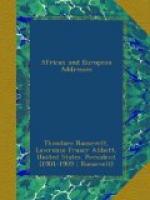Most of the great societies which have developed a high civilization and have played a dominant part in the world have been—and are—artificial; not merely in social structure, but in the sense of including totally different race types. A great nation rarely belongs to any one race, though its citizens generally have one essentially national speech. Yet the curious fact remains that these great artificial societies acquire such unity that in each one all the parts feel a subtle sympathy, and move or cease to move, go forward or go back, all together, in response to some stir or throbbing, very powerful, and yet not to be discerned by our senses. National unity is far more apt than race unity to be a fact to reckon with; until indeed we come to race differences as fundamental as those which divide from one another the half-dozen great ethnic divisions of mankind, when they become so important that differences of nationality, speech, and creed sink into littleness.
An ethnological map of Europe in which the peoples were divided according to their physical and racial characteristics, such as stature, coloration, and shape of head, would bear no resemblance whatever to a map giving the political divisions, the nationalities, of Europe; while on the contrary a linguistic map would show a general correspondence between speech and nationality. The northern Frenchman is in blood and physical type more nearly allied to his German-speaking neighbor than to the Frenchman of the Mediterranean seaboard; and the latter, in his turn, is nearer to the Catalan than to the man who dwells beside the Channel or along the tributaries of the Rhine. But in essential characteristics, in the qualities that tell in the make-up of a nationality, all these kinds of Frenchmen feel keenly that they are one, and are different from all outsiders, their differences dwindling into insignificance, compared with the extraordinary, artificially produced, resemblances which bring them together and wall them off from the outside world. The same is true when we compare the German who dwells where the Alpine springs of the Danube and the Rhine interlace, with the physically different German of the Baltic lands. The same is true of Kentishman, Cornishman, and Yorkshireman in England.
In dealing, not with groups of human beings in simple and primitive relations, but with highly complex, highly specialized, civilized, or semi-civilized societies, there is need of great caution in drawing analogies with what has occurred in the development of the animal world. Yet even in these cases it is curious to see how some of the phenomena in the growth and disappearance of these complex, artificial groups of human beings resemble what has happened in myriads of instances in the history of life on this planet.




